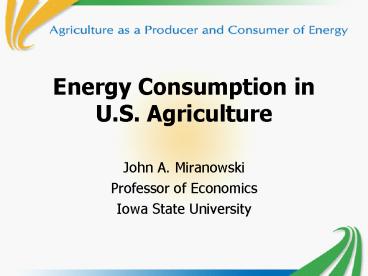Energy Consumption in U.S. Agriculture - PowerPoint PPT Presentation
1 / 42
Title:
Energy Consumption in U.S. Agriculture
Description:
Premise that energy consumption is driven by real energy and relative prices ... Irrigation. Energy Consumption by Production Region ... – PowerPoint PPT presentation
Number of Views:28
Avg rating:3.0/5.0
Title: Energy Consumption in U.S. Agriculture
1
Energy Consumption in U.S. Agriculture
- John A. Miranowski
- Professor of Economics
- Iowa State University
2
Introduction
- Premise that energy consumption is driven by real
energy and relative prices - Agriculture may be more vulnerable to energy
disruptions than to price shocks - Government policies provide incentives and
disincentives for energy consumption
3
Objectives
- Establish farm energy consumption baseline
- Evaluate responsiveness of producers to real
energy and other relative price changes - Assess vulnerability to energy supply disruptions
- Consider energy efficiency of farm production and
other sectors - Discuss roles of technology, farm policy, and
rural energy security
4
Current Farm Energy Consumption
- Direct energy diesel, gasoline, LP gas, natural
gas, and electricity - Indirect energy fertilizers and pesticides
5
6
Changes in Farm Energy Consumption over Time
- Diesel fuel and gasoline
- Electricity
- Fertilizers and pesticides
7
Total Energy Consumed on US Farms, 1965-2002
8
Energy Consumption and Farm Production
Expenditures
- Direct energy consumes twice as many BTUs as
indirect energy, but - Direct energy accounts for 5-7 of farm
expenditures - Indirect energy accounts for 9-10 of farm
expenditures
9
Direct and Indirect Energy Consumed on U.S.
Farms, 1965-2002
10
Energy Expenditures in Crop and Animal Production
- Field crop production
- Animal production
- Specialty crop production
- Irrigation
11
(No Transcript)
12
(No Transcript)
13
(No Transcript)
14
(No Transcript)
15
Energy Consumption by Production Region
- Fuel consumption in field crop producing regions
Corn Belt, Northern Plains, Southern Plains - Electricity consumption Pacific
- Fertilizer Corn Belt
- Potential indicators of vulnerability?
16
How do Producers Respond to Energy Price
Increases?
- What is happening to nominal and real energy
prices? - What aggregate response to a real energy price
increase would we anticipate from producers? - What other substitution opportunities are
available to producers?
17
Real Prices of major fuel sources 1970-2002
(1996 dollars)
18
(No Transcript)
19
Own Price Elasticities and Allen Elasticities of
Substitution
- Own price elasticity of energy - -0.60
- Own price elasticity of fertilizer - -0.66
- Own price elasticity of pesticides - -0.53
- Energy/capital substitution elasticity - 1.13
- Energy/fertilizer - 0.60
- Energy/pesticides - 0.70
- Energy/labor - 0.59
20
Off-Farm Energy Consumption in Agriculture
Processing
- Energy consumed in food processing
- 1.4 Quad BTUs in 2001
- 50 fuel and 50 electricity
- Energy consumed per dollar output
- Consumers demanding more processed and
convenience foods - Substituting energy in processing for energy use
in households
21
(No Transcript)
22
What is Happening to Farm Energy Efficiency?
- Is agriculture a profligate user of energy?
- Are producers improving energy efficiency over
time? - How does energy efficiency in agriculture compare
to other sectors?
23
Farm Productivity and Efficiency
- 2 annual productivity growth in AG
- Total inputs flat, but productivity and output
growing - Major inputs declining except energy and
chemicals after early 1990s - Partial productivity measures all increasing
24
Energy Intensity (BTUs consumed per dollar) in US
Agriculture, Food Manufacturing, Industry, and
U.S. Economy
25
Rural Energy Security and Rural Disruption Costs
- Energy disruption costs at points in production
and processing - Specialty crop harvesting
- Crop processing
- Animal production
- Animal harvesting
- Dairy production
- Fertilizer production
- Ethanol production
- Lack seasonal energy use data to assess such
disruption costs
26
Information and Biotechnology Impacts on Energy
Efficiency
- Continuation of productivity growth
- Substitute information for other inputs
- Substitute biotechnology for fertilizer,
pesticides, energy, and pharmaceuticals - Substitute information and knowledge for
traditional breeding and husbandry
27
Integrating Farm Energy Consumption and Production
- Wind energy offers opportunities for integrated
on-farm production and consumption - Bio-fuels have more limited potential and scale
problems - Solar offers potential power for livestock
watering, electric fencing, and lighting in more
remote areas
28
Policy Impacts on Farm Energy Consumption
- Farm policy may impact farm energy use
- Rural energy security policy concerns
- Farm Security and Rural Investment Act of 2002
- Renewable Energy Loans and Grants
- Energy Audits and Renewable Energy Development
- Technical Assistance to Develop Renewable Energy
Resources - Biofuels Research and Development
29
Conclusions and Implications for Farm Energy Use
- Important consumer of direct and indirect energy
in crop and animal production - Producers do respond to real energy price
incentives and do make input and output
adjustments - Vulnerability to energy supply disruptions may be
critical in specific time periods
30
Conclusions and Implications for Farm Energy Use
(cont.)
- AG is energy efficient relative to other sectors
and improving in response to real price increases - Farm and rural policies do have an impact
- on rural energy consumption
31
Thank You!
32
Supporting Slides
33
Energys Share of Farm Production Expenses
34
Direct Energy Expenditure per Dollar of Output in
Major Agricultural Crops
35
Direct Energy Consumption in top 5 NASS
Production Regions
36
(No Transcript)
37
(No Transcript)
38
Nominal Prices of major fuel sources 1970-2002
39
Own Price Elasticity and Input Substitution
Elasticities
Input Land Labor Capital Energy Fertilizers Pesticide
Land -0.28
Labor -0.27 -0.39
Capital 0.73 0.65 -0.86
Energy 0.35 0.59 1.13 -0.60
Fertilizers 0.20 0.82 0.97 0.60 -0.66
Pesticides 0.08 0.66 0.82 0.70 1.04 -0.53
40
Indices of Farm Output, Input Use and
Productivity in US Agriculture
41
Indices of Major Farm Inputs Usage in US
42
Partial Productivity indexes in US Agriculture































